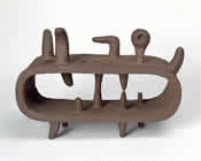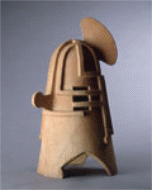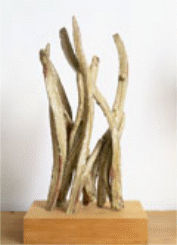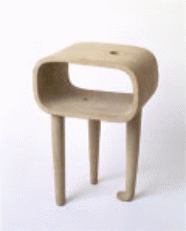Introduction
Pottery is an ancient art form that dates back to prehistoric times and has spanned the entire globe. It is so old and so prevalent that ancient cultures, of which we know very little, remain identified today by the pottery they produced. Generally speaking, ceramics is a term used today to denote any type of clay used to fabricate shapes that are then hardened with the use of heat. It can be made of a variety of materials that provide it with texture and weight, formed into any shape that can be as functional as a pitcher or as non-functional as an abstract statue. It can be mixed with particular minerals to provide it with a certain color or pattern or it can be painted and glazed to provide more control over the material. At one time, the ability to create pottery meant the difference between a group of people starving or being able to store food, carry water, or do any number of things.
Now, numerous other materials can be used for these purposes and ceramics seemed to have gone out of style. However, in some areas of the world, ceramics as an art form was never abandoned and in the present day, ceramics has seen a comeback in the art world.
Ceramics in Japan
Japan is one of those areas of the world that never wholly abandoned its appreciation and exploration into the art of ceramics.
“Nowhere is there as great an appreciation for the potter’s art as in Japan. Many competitions are held on both national and local levels and are widely reported in the press. Success in these contests is often critical for the artist’s career and plays no small part in what he can charge for his work. Exhibitions occur regularly in the most prestigious of venues, where collectors compete for the finest pieces” (Singer, 2004). The appreciation and knowledge of ceramics in Japan are astounding compared to Western traditions particularly as ancient forms are explored and incorporated into new ideas and new approaches. However, it was Western influences following World War II that brought Japan’s ceramics workers out of their more traditional molds and into the world of exploration and innovation. With this new attitude, groups such as the Sodeisha Group were formed that enabled further exploration into the art and expression of ceramics without any necessary emphasis on function, tradition, or form. One of the pioneers of this approach was Isamu Noguchi.
Isamu Noguchi’s creativity
Although Noguchi did not work primarily in ceramics, perhaps known much more for his larger sculptures, his impact within the world of ceramics was profound. Within his lifetime, he watched the world fall apart as America lived in the waged war against the Japan of his childhood and ancestry. In attempting to find his identity within these oppositions, pottery emerged as the connecting link. While much of his other work was produced in New York, his ceramics were all made in Japan. “But for Noguchi, the link between ceramics and Japan was more than a matter of access to specific materials and techniques. In 1952 he wrote, ‘I have only made pottery in Japan, never elsewhere.
I think the earth here and the sentiment here are suited to pottery’” (Cort & Winther-Tamaki, 1). At the same time that he was making a profound connection with the earth of his homeland, though, Noguchi was also perhaps inadvertently making a connection between the ancient materials of the past and the new materials of the future as his forms frequently took on characteristics of his other mediums – metal, plastics, and industrial compounds.
While much of Noguchi’s work is traditionally interpreted to reflect the artist’s reconnection with his roots and the earth of his birthplace, it can also be seen to bridge the gap between the old and the new approaches to art, craft, and the ancient ways. The height of his ceramic work coincides with the Sodeisha Group and helped to inform the new generation of pottery workers, forming a link between the techniques of the past and the expressions of the future even as his very existence bridged national borders to introduce international ways of thinking into nationalistic traditions and beliefs. The purpose of this exhibition, then, is to provide a glimpse into the artwork of Isamu Noguchi and illustrate the various ways this artwork has served as a bridge between multiple worlds.

“Tiger” is a small free-standing piece that captures the essence of the animal it’s named for without actually pictorially representing it. Generally, the piece consists of a flat, hollow ovoid shape standing on four tiny legs. The legs are not symmetrical from side to side, but they are matched from front to back on each side. This gives the piece a sense of motion, as well as stability as the two legs on the forward side, appear to be in motion, reaching slightly forward while the two legs on the far side appear to be much more solid pegs, firmly rooted into the ground.
The ovoid shape is pierced in the center by what might best be described as stalactites and stalagmites, which reach to connect in the center. Only one of these pairings does so, however, and the effect is of a mouthful of teeth aching to come together. The top of this ovoid shape is decorated with a series of upwardly projecting curved and blunted points reminiscent of alert ear movements, peering eyes, and an upright tail, completing the impression of a hunting dangerous wild cat of the primeval forest without ever actually including a specific reference point.
In its unglazed stoneware condition, this piece represents the pottery of the past and the undeveloped treatment of the technique. It is constructed of unglazed Kasama red stoneware, which was known for its utilitarian structure. “The Kasama kilns made sturdy everyday vessels such as storage jars, mixing mortars and teapots” (Kogeikai, 2004). In this unfinished condition, primitive imagery and traditional material, Noguchi has managed to imbue his piece with a strong sense of the past and the ancient arts.
However, in his choice of form and symbolism, he is undeniably working out of a more modern conception, focusing upon the impression rather than the depiction and conveying the emotions rather than the picture.

This piece depicts a traditional Japanese war helmet with a few stylistic liberties taken. The helmet is too conical to have been of much use in protecting a warrior’s head and includes impractical features that would have made waging battle nearly impossible. The helmet stands on its own, resting easily upon three ‘feet’, thin, wedge-like shapes that retain a sense of their function in the small curved elements toward the base. Geometrically patterned raised horizontals and verticals elongate the helmet’s appearance even as they serve to point the way toward an almost indiscernible face grill that again seems too small and improperly placed for actual use or true representation. Most striking about the piece, though, is that despite its clean lines and purposeful structure, it features two appendages that seem to serve no purpose but to call attention to themselves. The first of these is an inverted and heavily blunted ax-like wedge at the crown of the helmet, seeming to suggest the shape of the ax-head as it cleaves out of the head. The other is a circular tab at the side serving no particular purpose at all.
The lack of purpose and direction seems to be the overriding theme of this piece. Made of unglazed Shigaraki stoneware, it again reverts to the ancient materials and highlights the pointlessness of creating a helmet out of such easily breakable materials. Shigaraki stoneware is characterized by its rough, orange-firing clay and a characteristic rustic appearance (Kogeikai, 2004). At no point does the helmet appear to be useful or helpful to the soldier unfortunate enough to be required to wear it. It is cumbersome and improperly proportioned for the human head and features elements with no obvious intended purpose at all.
Produced during his final period of ceramics-making, the helmet is undeniably a reflection of what was learned in the war just past as well as a connection between this and the history of the ancients.


References
Cort, Louise Allison. “Crawling Through Mud: Avant-Garde Ceramics in Postwar Japan.” The Schein-Joseph International Museum of Ceramic Art. New York: New York State College of Ceramics at Alfred University, 2003. Web.
Cort, Louise Allison & Winther-Tamaki, Bert. Isamu Noguchi and Modern Japanese Ceramics: A Close Embrace of the Earth. California: University of California Press, 2003.
Kogeikai, Nihon. Handbook for the Appreciation of Japanese Traditional Crafts. (2004). Web.
Singer, James. “Contemporary Japanese Ceramics.” Asian Art. (2004). Web.
National museum of Asian Art. Web.